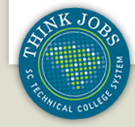Distance Learning
The S.C. Technical College System serves a diverse population of students who sometimes find it difficult to gain an education in the traditional format, such as attending scheduled classes as a full time student. Courses offered in the various distance learning formats allow these non-traditional students to meet their educational goals while maintaining employment and accommodating their personal and occupational schedules. A variety of instructional methodologies are used to deliver instruction so the student can attend classes anytime, anyplace.
Need an online course? Find it here.
Please contact the technical college for their online course offerings.
The TechOnLine Consortium of Colleges
![]() The TechOnLine Consortium of Colleges website is designed to provide an easy method for member colleges to share online courses. Students may search for courses and can request enrollment and registration. Not all colleges are members.
The TechOnLine Consortium of Colleges website is designed to provide an easy method for member colleges to share online courses. Students may search for courses and can request enrollment and registration. Not all colleges are members.
Other distance learning offerings of the SC Technical College System:
Teleclasses are courses that are delivered live from one origination site to multiple receive sites. This allows the student to attend class at the receive site nearest his/her home and see the live instruction on TV sets in the classroom. Teleclasses are interactive, meaning that the student can see and communicate with the instructor at the origination site and the students at the other receive sites. This allows the student to save valuable travel time by taking the class at the most convenient sites. Some teleclasses are delivered to other technical colleges in the state over extended distances in order for students to have access to a wide variety of courses in addition to those offered at the technical college in their area. If students in one geographic area are not sufficient in number to justify a traditional class then a teleclass could be offered with the total number of students from all sites making up the minimum number for the class. For example, if the minimum number required to run a class is fifteen, then there may be seven students in the class at the origination site, three at site #1, two at site #2, and three at site #3. Those at the three remote sites could not justify a traditional class in that area, but benefit from the total at all sites. Telecourses are courses delivered on videotape or on cable TV. The lectures/demonstrations are recorded on tape and the student watches the tape at home at his/her convenience or through scheduled programming on their local cable TV network. Communication with the instructor is through scheduled meetings, phone calls or email. The only equipment normally needed is a TV and VCR to view the tapes. Visits to the campus are limited and vary from course to course—i.e., for orientation, labs, or tests. These courses are portable and ideally suited for someone who must travel, since a TV and VCR are the primary tools required for instructional delivery.
Web based courses are delivered on the Internet using software designed specifically for the delivery of instruction. These courses can be synchronous (all students in the class online at specific times) or asynchronous (log on and study anytime) or a combination. The only equipment required for most courses is a computer, modem and access to the Internet. Communication with the instructor and other students is normally through email and students can interact through discussion groups in online chat rooms. Asynchronous courses are truly anytime, anyplace because the student can log on to the course site at his/her convenience, review materials and complete assignments. Online interaction with other students allows students to learn from each other as well as from the course materials and instructor.Some technical colleges use various combinations of the above delivery methods, depending on the subject matter. Some courses are designed to be primarily web based, but also include videotapes as part of the instructional package.The sixteen technical colleges in the System are hard at work designing courses and programs that can be delivered in a format convenient to the student so that citizens of South Carolina will have one less barrier to address in the pursuit of their educational goals.
The Future
Technology changes almost overnight. The S.C. Technical College System strives to maximize the use of the latest technology in order to bring quality instruction to the citizens of this state regardless of their location or schedule. Streaming video, rich media, and virtual simulations are just a few of the methods that are revolutionizing the way colleges present instruction. The quality of these courses matches or exceeds that of the traditional classroom method because the technology enhances the potential creativity of the instructor and allows the material to be presented in a variety of formats. As new technology is developed and matures, the S.C. Technical College System will continue to implement new methods to provide quality instruction for the widest possible audience.

